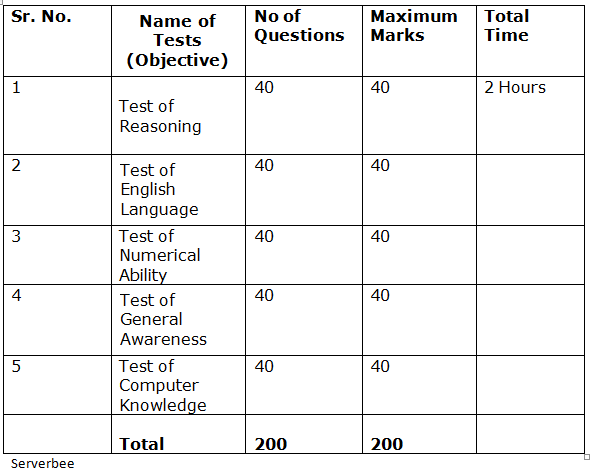Aspirants willing to land a job in Reserve Bank of India (RBI) , the Central bank of the country are informed of the great opportunity as RBI has recently issued the latest RBI Assistant 2015 Recruitment Notification on its official portal for the recruitment of “Assistants” in various offices of the Bank.
RBI Syllabus
RBI Officers in Gr ‘B’ (General) - DR Exam Syllabus
Phase-I ON-LINE Examination (Objective Type) 200 marks.
- The Paper consists tests of Candidates have to secure minimum marks separately for each test as well as aggregate, as prescribed by the Board.
- Candidates, who secure minimum marks separately for each Test, as prescribed, will be shortlisted for Phase-II of the Examination based on the aggregate marks obtained in the Objective Test.
- The minimum aggregate cut off marks for being shortlisted for Phase-II of the Examination will be decided by the Board in relation to the number of vacancies. Roll No. of the candidates shortlisted in Phase-I of the On Line Examination (‘OE’) will be published on RBI website.
(II) Phase-II Written Examination (Descriptive Type)- The Phase-II Written Examination (WE) will be conducted in September/ October 2014 (tentative) only for those candidates who are shortlisted for the same.
- The date and time-table will be intimated to the candidates concerned at the appropriate time.
- The Examination will consist of three Descriptive Type papers – (i) Paper I – English (ii) Paper II – Economic and Social Issues and (iii) Paper III – Finance and Management. Each of these papers is of 3 hours duration carrying 100 marks.
NOTE- Phase-I (except the test of English) and Papers II and III of Phase-II will be set bilingually in Hindi and English.
- Phase-I will be ONLINE (Objective Type) and only marking the correct choice is required. However, Papers II and III of Phase-II can be answered either wholly in Hindi or in English at the candidate's option.
Syllabus (Phase-II)
(i) Paper I
- English: Essay, Précis writing, Comprehension and Business/Office Correspondence.
(ii) Paper II- Economic and Social Issues: Growth and Development
- Measurement of growth: National Income and per capita income – Poverty Alleviation and Employment Generation in India – Sustainable Development and Environmental issues. Economic Reforms in India – Industrial and Labour Policy – Monetary and Fiscal Policy – Privatisation – Role of Economic Planning.
- Globalization – Opening up of the Indian Economy – Balance of Payments, Export-Import Policy – International Economic Institutions – IMF and World Bank – WTO – Regional Economic Co-operation.
- Social Structure in India – Multiculturalism – Demographic Trends – Urbanisation and Migration – Gender Issues – Social Justice : Positive Discrimination in favour of the under privileged – Social Movements – Indian Political System – Human Development – Social Sectors in India, Health and Education.
(iii) Paper III
Finance and Management
Finance - The Union Budget – Direct and Indirect taxes; Non-tax sources of revenue; Outlays; New Measures.
- Financial Sector Reforms; Capital Market, Money Market and Foreign Exchange Market; Stock Exchanges and their Regulation; Capital Market Intermediaries and their Regulation; Role of SEBI;
- Functions of the Money Market; Growth and Operation of the Money Market; The Foreign Exchange Market; From FERA to FEMA; Exchange Rate Management; Exchange Risk Management; Role of Banks and Financial Institutions in Economic Development; Regulation of Banks and Financial Institutions; Disinvestment in Public Sector Units.
Management- Management: its nature and scope; The Management Processes; Planning, Organisation, Staffing, Directing and Controlling; The Role of a Manager in an Organisation. Leadership: The Tasks of a Leader; Leadership Styles; Leadership Theories; A successful Leader versus an effective Leader.
- Human Resource Development: Concept of HRD; Goals of HRD; Performance Appraisal – Potential appraisal and development – Feedback and Performance Counseling – Career Planning – Training and Development – Rewards – Employee Welfare. Motivation, Morale and Incentives: Theories of Motivation; How Managers Motivate.
- Concept of Morale; Factors determining morale; Role of Incentives in Building up Morale. Communication: Steps in the Communication Process; Communication Channels; Oral versus Written Communication; Verbal versus non-verbal Communication; upward, downward and lateral communication;
- Barriers to Communication, Role of Information Technology. Corporate Governance: Factors affecting Corporate Governance; Mechanisms of Corporate Governance.
NOTE- The above syllabus is only indicative and not exhaustive. Keeping in view that candidates from different faculty backgrounds apply for the post, the questions in Papers II and III will be basic in nature.
Pattern

- A candidate has to qualify in each part of the Objective test separately. There will be negative marks for wrong answers in the Objective tests. 1/4th marks will be deducted for each wrong answer. Candidates will have to pass in each of the objective tests.
- Reasoning, with composite time of 130 minutes.
RBI Exam 2015 Pattern
RBI Assistant Exam Pattern
- The Online Examination will be for 200 marks.
- The above tests except the Test of English Language will be available bilingually, i.e. English and Hindi.